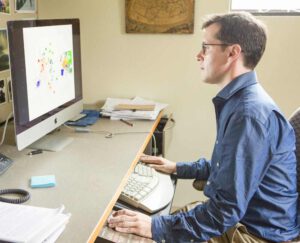DNA has been described as both a recipe for life and a record of it, and computational biologist John Novembre – who recently received a MacArthur Foundation “genius grant” for his work – is showing just how powerful melding those two elements together can be for scientists.

Photo Courtesy of the John D. & Catherine T. MacArthur Foundation
Novembre, who we first wrote about seven years ago, was recognized for his innovative research that used aggregated genetic information to create “genetic maps” of Europe, and he also lead a team that studied the recombination rates in admixed individuals, particularly African Americans.
Using what we know about recombination rates, he has been able to pinpoint when rare genetic variants emerged in human populations.
23andMe population geneticist Kasia Byrc, who was a co-author on Novembre’s “Genes Mirror Geography in Europe” paper said she liked that there is often a strong geographic component to his work.
“A lot of his work is focused on understanding the geography of genetic variation, and in turn, learning about what a population’s history was based on looking at the present-day genetic patterns. He’s also a brilliant computational biologist.”
While at UCLA Novembre developed ADMIXTURE, an ancestry-estimation algorithm that powers some genetic ancestry testing company’s results. The algorithm took what was previously an innovative, but computationally slow method – called STRUCTURE – and created a much faster algorithm to make these estimations possible with very large and rapidly-growing datasets., Kasia said.
His work is improving scientists’ ability to estimate recombination rates within admixed populations. This is helping researchers understand how genetic material gets shuffled up before it gets passed on to the next generation.
But beyond insights about ancestry, Novembre’s detailed study looking at the introduction of rare and damaging genetic variants into the human genome will add to our understanding of the genetics of certain disease and how it differs among different populations.


